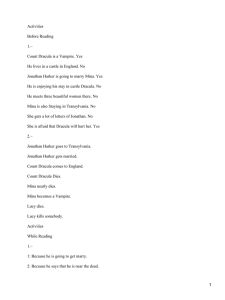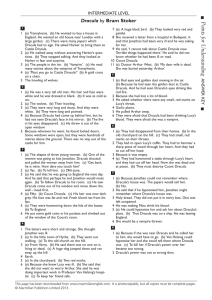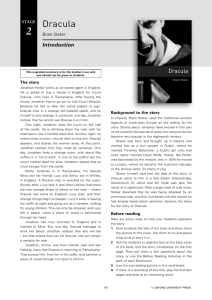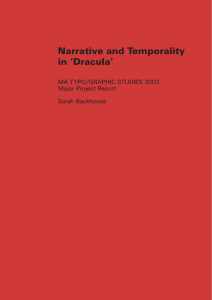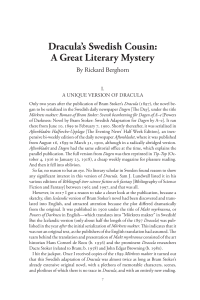“This Man Belongs to me!”: Edward Carpenter, Dracula, and
Anuncio
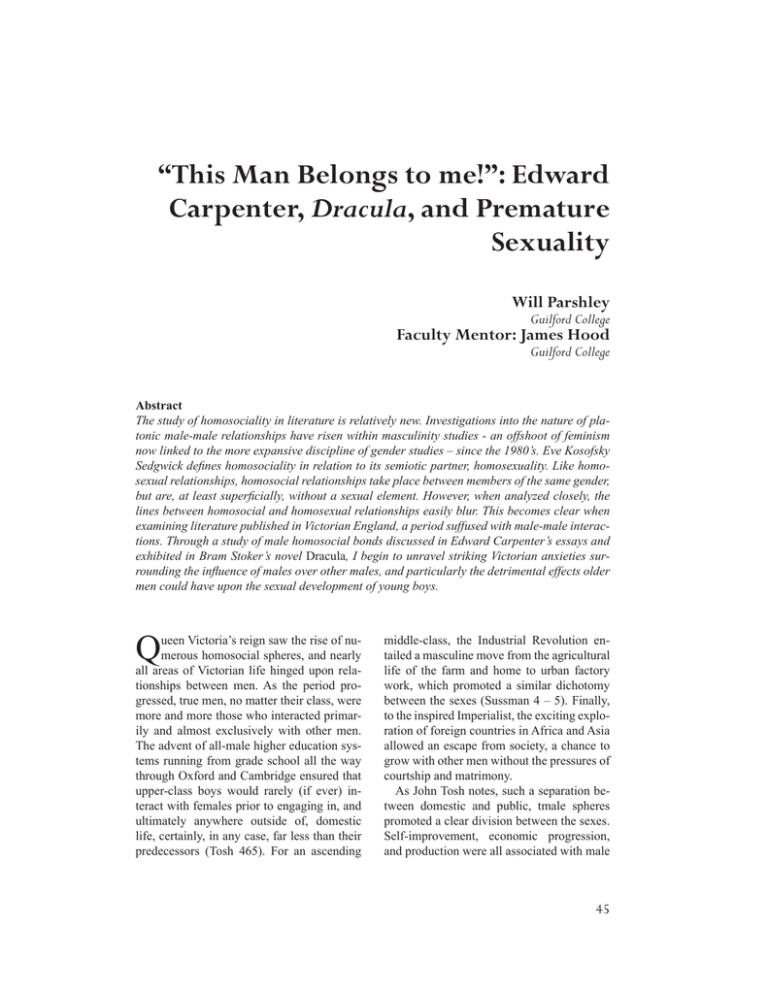
“This Man Belongs to me!”: Edward Carpenter, Dracula, and Premature Sexuality Will Parshley Guilford College Faculty Mentor: James Hood Guilford College Abstract The study of homosociality in literature is relatively new. Investigations into the nature of platonic male-male relationships have risen within masculinity studies - an offshoot of feminism now linked to the more expansive discipline of gender studies – since the 1980’s. Eve Kosofsky Sedgwick defines homosociality in relation to its semiotic partner, homosexuality. Like homosexual relationships, homosocial relationships take place between members of the same gender, but are, at least superficially, without a sexual element. However, when analyzed closely, the lines between homosocial and homosexual relationships easily blur. This becomes clear when examining literature published in Victorian England, a period suffused with male-male interactions. Through a study of male homosocial bonds discussed in Edward Carpenter’s essays and exhibited in Bram Stoker’s novel Dracula, I begin to unravel striking Victorian anxieties surrounding the influence of males over other males, and particularly the detrimental effects older men could have upon the sexual development of young boys. Q ueen Victoria’s reign saw the rise of numerous homosocial spheres, and nearly all areas of Victorian life hinged upon relationships between men. As the period progressed, true men, no matter their class, were more and more those who interacted primarily and almost exclusively with other men. The advent of all-male higher education systems running from grade school all the way through Oxford and Cambridge ensured that upper-class boys would rarely (if ever) interact with females prior to engaging in, and ultimately anywhere outside of, domestic life, certainly, in any case, far less than their predecessors (Tosh 465). For an ascending middle-class, the Industrial Revolution entailed a masculine move from the agricultural life of the farm and home to urban factory work, which promoted a similar dichotomy between the sexes (Sussman 4 – 5). Finally, to the inspired Imperialist, the exciting exploration of foreign countries in Africa and Asia allowed an escape from society, a chance to grow with other men without the pressures of courtship and matrimony. As John Tosh notes, such a separation between domestic and public, tmale spheres promoted a clear division between the sexes. Self-improvement, economic progression, and production were all associated with male 45 Explorations | Art and Humanities homosocial arenas of education, industrialization, and colonization, whereas females relegated to the home – “angelic” keepers of a “spiritual… shrine” -- were markedly limited in their physical, social, and mental mobility (Tosh 463). In turn, interaction between the genders waned, and by the latter half of the century, virile adventure writers like H. Rider Haggard were rejecting the constant and expected discourse between men and women once epitomized in Netherfield Hall. Thus, male-bonding became a centerpiece in Victorian society and, importantly for our purposes here, within its literature. Eve Kosofsky Sedgwick’s commentary on erotic, Oedipal triangles provides a helpful, theoretical basis from which to investigate ties between men in this work (21). The Oedipal triangle is a Freudian notion, a tenet of the psychoanalyst’s theory of development famously figured around Sophocles’ great Athenian tragedy. In Freud’s eyes, a “homoerotic identification with [the] father, a position of effeminized subordination to the father” is vital to a boy’s development of proper heterosexuality; through such a close bond, the boy is provided a “model for his own heterosexual role” by watching his father’s interactions with his mother (Klein as qtd. in Sedgwick 23). Due to ubiquitous male-male interactions in Victorian England, a boy often engaged with one or more mentors -- “surrogate fathers” -- involved in whichever male sphere he entered (Sussman 100). The men might be comrades on the Colonialist lines, older male students, or even male teachers. Using Freud’s Oedipal theory, we can begin to untangle the intimate ties that grew between elders and youth. Such an investigation reveals an intriguing resemblance and resonance of ideas existing between Edward Carpenter’s essays and Bram Stoker’s most famous work, Dracula. This resonance lies in the simultaneous celebration of and cautioning against male-male, and particularly manboy, relationships. Thus, both pieces evince a tension on the part of the writers, who reveal a considerable Victorian anxiety surrounding the proper facilitation of such relationships. 46 I Edward Carpenter, a pioneering gay writer of the Victorian period, was born in Brighton in 1844. The son of a well-to-do investor, Carpenter was raised in considerable wealth and luxury. Thus, as biographer Sheila Robowtham notes, after attending Cambridge, Carpenter might have settled into the easy life of an indolent priest for a small parish community (Robertson 53). In fact, this was Carpenter’s intended track. However, just weeks before his ordination, Carpenter (much like others after) endured a revelatory experience upon reading Whitman’s Leaves of Grass, and began to view the complaisant, refined setting of Brighton through a different lens (53 – 54). Carpenter became active in the British socialist movement, and throughout his life campaigned for progress in a variety of social areas, including but not limited to “feminism, anticolonialism, [and] environmentalism” (53). Close acquaintance E.M. Forster once aptly described Carpenter as “a poet, prose writer, a prophet, a socialist, a mystic, a manual laborer, an anti-vivisectionist, etc. etc. etc. …” (as qtd. in “Homogenic Love” 535). Yet Carpenter left his most lasting impressions with his works on sexuality. Writing an abundance of texts on the clandestine topic of “homogenic love,” Carpenter promoted radical leftist notions that remain relevant to modern society. While many of his early essays and their topics required small, furtive publications for a select audience, this changed when Carpenter published a landmark essay in 1899 in the International Journal of Ethics. The piece focuses upon the pervasive relationships between men and boys then taking place in the public schools, a subject that, following the infamous Oscar Wilde trials in 1895, was severely troubling the public conscience. In his article “Affection in Education,” published 1899, Edward Carpenter argues that male-male relationships in the public school, particularly those between elder and youth, are imperative to boyhood development. Often far away from their homes, Will Parshley schoolboys looked to older males (“surrogate fathers”) for guidance. Carpenter opens in vigorous celebration of the warm affection that grows between mentor and protégé. Letters from numerous men reveal the passion they had for a beloved elder: “… when I saw him, my heart beat… violently… and I could not speak,” writes one who remembers writing “weekly, veritable love-letters” to an elder boy at his school (483). However, Carpenter is quick to note and to continuously reassure his readers of the absence of sexual attraction between the two parties. He explains that the older does not approach the boy with “secondary motives” or “personal ends,” allowing these “strong affections” to arise “quite spontaneously” (484). In other words, Carpenter is suggesting that the seeds of such attachments grow naturally. The teacher does not prompt the initiation of the relationship and makes no conscious effort towards the affection. Rather, the boy “naively allows his admiration” (484) to develop into a deep attraction. To reach full bloom, the bonds must be properly cultivated. The first step in developing the affectionate relationship is its acceptance. While the seeds sprout naturally, they develop through nurturance. Thus the elder must decide whether or not he will fulfill or “deny” (Carpenter 484) his role as mentor, and the benefits of the former are boundless. For the rest of the relationship, the boy models and shapes his behavior after the elder’s example, ultimately sharing the essence of his masculinity, the man’s “ideals of life and thought and work” (484). Further, the relationship deeply influences the boy’s sexual development. Carpenter’s reasoning sounds distinctly Freudian when he makes clear that adolescent boys are not fully sexualized. No actual conception of sex is yet formed: “desire… has not manifested itself strongly”, and the young boys likely experience a general aversion to “any thing like sexual practices” (489). The youth simply shows pubescent interest and it is the place of the same-sex mentor to answer his questions. In the initial development of sexual curiosity, the boys show no real interest in women, their “love to the other sex” having “hardly declared itself” (485); no true heterosexual attraction has formed. Even further, Carpenter claims that a boy’s “unformed mind requires an ideal of itself … towards which it can grow” (485). Thus, like the Oedipal relationship between father and son in which a boy attains a role of “effeminized subordination” to his father, the schoolboy’s introduction to sexuality occurs when he “imitates” and “contracts [the] habits” of his elder male mentor through a relationship with a “certain physical element,” a “real affection and tenderness” (484), before he develops a taste for females. Carpenter connects the development of heterosexuality to the fruition of masculinity: the boy’s relationship with his mentor prepares him for future interactions with the opposite sex, while simultaneously developing his “conduct of life and morals” (492). Such interactions provide the elder male an opportunity to influence the flourishing of the young child’s masculinity. Acting nobly and with an eye for the boy’s future, he can ensure that the youth grows into a man with substantial “strength of character,” capable of heterosexual relationships rich with love and affection (Carpenter 488). Yet when the elder attends to this bond perversely, his influence can be equally abject and detrimental. For example, if he attempts to form the bond unnaturally, with secondary motives, the consequences for the youth are dire; “the disease of premature sexuality” (486) between mentor and child “cheapens and weakens” the boy’s “affectional capacity” (488). Rather than “blossom[ing] the young mind” (489), these “wretched practices and habits” threaten the boy’s understanding of “true love and friendship” (486). Thus, and importantly, the breaching of such a potentially innocent, warm, and beneficial bond fogs the boy’s psychology; this early sexual experience “arrests” his “mental growth” (488). In an earlier paper titled “Homogenic Love and Its Place in a Free Society,” Carpenter defines sexual “mania” as an excessive form of, 47 Explorations | Art and Humanities or obsession with, “physical desire” (539). Thus, when discussing premature sexuality between men and boys, Carpenter is implying a potential madness that is born in the latter; they become lecherous fiends, “licentious… odious little wretches” (“Affection in Education” 487) with an insatiable desire for sex. Although his words may appear harsh or extreme, Carpenter reveals a fairly universal Victorian anxiety surrounding what occurs when males are prematurely and unnaturally introduced to sexual activity. A pioneering gay writer, Carpenter understands the subtleties of male-male relationships, yet there is a perceptible tension in his writing. While clearly celebratory of the bonds he describes, he appears equally concerned with the danger of their improper facilitation; on the one hand, Carpenter emphasizes the importance of man-boy relationships, and on the other, he warns against their potentially dire consequences. As we turn to Bram Stoker’s Dracula, published 1897, just two years prior to “Affection in Education,” we will begin to recognize very similar themes being played out in homosocial spheres beyond the public school. On the novel’s surface, Stoker clearly extols the beauty he sees in masculine bonding and comradeship. And yet, like Carpenter’s essay, Dracula simultaneously portrays the baleful effects that can occur when male-male relationships develop inappropriately. Indeed, as we will see, improper masculine interactions prove destructive for characters of both sexes. II The opening section of Dracula is its most eventful. The turmoil within Castle Dracula involves two men only. Jonathan Harker travels to Transylvania as a “solicitor’s clerk” whose purpose is to “explain the purchase of a London estate to a foreigner” (Stoker 21). That foreigner, of course, is Count Dracula, a man with birdlike features; diabolic red eyes, so often surrounded by darkness; and “peculiarly sharp white teeth” hanging over “lips” of “remarkable ruddiness” (23). By the 48 novel’s end, this horrific image of the Count is so fixed that it is often difficult to remember that the purpose of Harker’s trip was quite mundane; at this point in the narrative, Harker’s sole purpose is to inform Dracula of land that he has purchased in London. This point may sound obvious, but is very important when considering the relationship that develops between the two characters. Harker arrives in Transylvania on business, and thus enters the Victorian homosocial sphere of the workplace. Before we go further, we should note two characteristics of Harker’s journey that distinctly connect his situation to that of Carpenter’s schoolboys. Similarly to the young boys in Carpenter’s public schools, Harker finds himself in an area far away from home and without friends or family. He arrives at Castle Dracula in place of Peter Hawkins, the solicitor he works for who doubles as a father figure (Stoker 23). Hawkins’ role as primary mentor and father figure is secured when the Count reads aloud a letter describing Harker’s “[growth] into manhood in [Hawkins’] service.” Now, finding himself far away from Hawkins’ care, Harker must “take [Dracula’s] instructions in all matters” (23). In this way, Hawkins’ letter signifies an exchange in which a father passes his son off to a “surrogate father” as the boy enters a new, unfamiliar homosocial sphere. Thus, like a boyhood development dependent upon relationships with older men, Harker’s growth in this homosocial sphere will lean heavily upon his interactions with Dracula, a man who, having lived for centuries, is about as “elder” as one can be (212). Initially, the connection between Harker and Dracula appears natural. The Count even shares a few of Harker’s interests. In the castle’s library, Harker marvels at Dracula’s collection of “English books” that cover a range of subjects and disciplines, but is especially drawn with “gladdened heart” to the Count’s copy of the “Law List” (Stoker 25), a document directly relevant to his own work as a solicitor’s clerk. When the time comes for Harker to discuss the London land purchase Will Parshley with the Count, he remarks that the elder man posited “myriad questions,” and admits that Dracula is so knowledgeable that he likely “[knows] very much more” (28) than even he. Dracula’s aptitude for all things English, and particularly this familiarity with the practice of Law, sets the elder man up as a surrogate father that Harker might “contract the habits of.” Indeed, the situation seems opportune for the young man. Under the care of such a learned mentor in a new homosocial sphere, Harker may accrue skills, attain a deeper understanding, and further cultivate the masculinity planted during his time with Hawkins. Thus Harker’s relationship with Dracula -- a surrogate father with the potential of being a true workplace mentor – could potentially bolster the young man’s masculine development. However, despite the bond being a homosocial one formed through business, the two men’s relationship quickly grows sensual. The affection that the Count shows Harker further establishes his role as both surrogate and Oedipal father. If this affectionate bond were healthy, Harker would be able to reach his full potential within the homosocial sphere, and his masculinity would take a major step if he were to establish the “manhood” he found with Hawkins in an entirely new arena. However, this proves impossible, as Dracula breaks one of Carpenter’s crucial tenets. When the Count “leans over [Harker]” to affectionately stroke him, evoking a “shudder” (Stoker 24) from the young man, he is initiating contact with a secondary motive. Harker has not “naively allow[ed] his admiration” to grow into a deep attraction; rather, the Count is touching the man consciously, evidenced by his “drawing back” upon being “noticed” (24). Unlike the fruitful relationships that spring naturally between boys and mentors, this affection between the two men is purposefully initiated by the elder. This allows Dracula a level of control over their interactions that Harker does not have. The young man is particularly vulnerable: he is separated from society and thus in the hands of Dracula, expected to fulfill all of the man’s wishes on account of business. Harker even admits that to the Count “alone can [he] look for safety” (41). The Count need not wait for Harker to show interest; he must simply take advantage of what is already an optimum situation; the castle is a “veritable prison,” and Harker its “prisoner” (Stoker 32). In this context, Dracula’s sordid influence can continue unchecked, and with time such influence begins to turn the relationship from homosocial to homoerotic. There are conspicuous signs that the relationship is growing unhealthy, especially when Dracula threatens to violently penetrate Harker after seeing the man’s blood (Stoker 31; Craft 446). The climactic interaction between the two men -- which criticism of the novel has explicated tirelessly -- occurs in the castle’s west wing. At this point in the novel, Harker has gone directly against Dracula’s advice and fallen asleep in an area away from the safety of his room. He awakens in a dreamlike state, and before long, three female vampires (reminiscent of Macbeth’s weird sisters) appear and threaten, like Dracula previously, to pierce Harker. Yet Dracula cannot have this; he has been prepping the young man for over a month. With his emphatic line “This man belongs to me!” (43), Dracula claims Jonathan Harker and establishes his homosexuality within the novel. Harker then swoons, and our interpretation of their interaction (and potential intercourse) is left to speculation. Yet when Harker wakes the next morning with his clothes folded by his bedside, presumably by the Count, we can assume that their interaction was more than friendly (44). Further, if we are to believe that a sexual act did take place between the two, we must remember that because the affection did not grow naturally, this would constitute a “premature sexual act,” as Dracula has specifically taken advantage of a vulnerable, younger man. After this crucial moment, Harker’s sexuality begins to change. In her article “A Wilde Desire Took Me,” Talia Schaffer references other critics who characterize the Count’s debased chapel as “the anal orifice… littered… 49 Explorations | Art and Humanities with Dracula’s fecal/phallic coffins” (Hanlon as qtd. in Schaffer 480). As such, the chapel becomes the setting for the most direct male-male penetration between Dracula and Harker in the novel. Imprisoned in the castle, Harker is forced into Dracula’s temple out of necessity, realizing that his only chance at escape is to procure Dracula’s master key. Thus although Harker seeks control of his own destiny by taking “action!” (49), it is action that is intrinsically linked to his lack of control in the castle. As Harker descends into the Count’s lair, through the “dark, tunnel-like passage, through which came a deathly, sickly odour” (Stoker 50), it is he who is penetrating Dracula’s, albeit symbolic, anal orifice. Figuratively, the young man is committing an uncontrollable sexual penetration; given what has occurred between himself and the Count, this penetration cannot be avoided. Further, the behavior becomes habitual. When a “wild desire” brings Harker back through the “dark passage” in another desperate attempt to “obtain (the) key,” Harker is well accustomed to the clandestine activity, stating, “I knew now well enough where to find the monster I sought” (53). Dracula’s sexual influence thus causes Harker to perform a homoerotic act, one reminiscent of the dark and “wretched practices” that Carpenter sees as products of premature sexuality in public schools. By the close of the novel’s opening section, Jonathan Harker is a fallen man. While the young solicitor’s clerk arrives with a certain degree of manhood in this new homosocial sphere, he falls victim to an Oedipal father figure who traps and perverts his proper masculine development by unnaturally breaching the line between the homosocial and the homoerotic. Stoker presents Harker’s homoeroticism as a perversion, a development caused by Count Dracula’s uncontrollable sexual deviance. Deliberately or not, Stoker is portraying a darkened image of the homosexual man. Dracula is a man who, unable to control his lust for blood and penetration, stains a young man’s masculine development. He causes unnatural homoerotic desires to grow within Harker’s mind, such uncontrollable “physical desires” that lead 50 him into Dracula’s chapel. Thus Stoker appears to be illustrating a considerable anxiety surrounding homosexuality, and the potential corruption it can cause young men during their sexual development. Luckily for Jonathan Harker, he is saved by a symbolic crux of masculinity within the novel: in the hospital, he is married. While recovering from his “violent brain fever” (Stoker 95) -- a diagnosis implicating the “mental arrest” he experienced in the castle -Harker is still vulnerable to the Count, whose presence always threatens to subvert his manliness; nurses remind Mina that she must be careful with her husband, for “the traces of such an illness… do not die lightly away” (95). But when the couple observes Dracula for the first time in London, and Harker is “evidently terrified at something” (155), he can lean on his wife, or the symbolic bond of marriage, for support. We are left wondering what might have happened without Mina at his side; the woman herself is convinced that “he would have sunk down” (155). It appears then that the symbolic value of the heterosexual marriage in a way helps to control, or at least veil, Harker’s homoerotic desires. In other areas of the novel, heterosexual relations play a similarly pivotal role in one’s masculine identity. Moving to the other major homosocial sphere in Dracula, we will see that marriage, or the prospect of marriage, is an ideal that is crucial for one’s development of true manliness. III Opposite Dracula and Jonathan Harker’s homosocial interaction is The Crew of Light. This group consists of three close friends, Dr. Seward, Quincey Morris, and Arthur Holmwood, who were intimate long before the events of the novel take place. Together, they carried the Imperialist banner to the frontier of “Titicaca” and “Korea” (62), and Morris’ acute recollection of these past experiences reveals how close he keeps the memories to his heart. His laconic letter to Holmwood early in the narrative reveals that the familiarity between friends is not only emotional, but quite physical; by Will Parshley memorializing “dress(ing) one another’s wounds” (62), Morris fondly remembers an act that would have drawn each man intimately close to the other’s body. Having returned from the frontier, The Crew of Light finds itself transfixed around the angelic Lucy Westenra. A mutual love for the young girl connects the three friends, and marrying Lucy would prove pivotal in establishing one’s masculinity. As we saw with Jonathan Harker, marriage would help veil any potentially homoerotic experiences that took place on the Imperialist frontier. As the sought after female, Lucy retains the role of moderator; her choice will uphold the masculinity of one man, and jeopardize two others. She finds herself conflicted: “Three proposals in one day! Isn’t it awful! ... I am so happy that I don’t know what to do with myself” (Stoker 57). Her ambivalence is justified, having just accepted her love, Arthur Holmwood, while recognizing the risk she’s caused “two of the poor fellows” (57) in rejecting them. Thus Quincey Morris and Dr. Seward enter the novel on unstable ground. Having been denied the heterosexual security of marrying the woman they love, both characters must re-establish their roles as men. For Quincey Morris, such a challenge does not prove difficult, for he is a “True Gentleman.” Morris is most distinguishable from others in the Crew of Light due to his use of American slang, a characteristic that threatens his chances with Lucy; he’s so funny, so “jolly and good humored,” that the young girl mistakenly teases the man as he prepares to propose (Stoker 58 – 59). His silliness might have eased Lucy’s rejection; it wasn’t “half so hard” for Lucy to deny his proposal as it was for her to deny Dr. Seward’s (59). However, Morris recognizes his slip-up. Mid-proposal, he turns his tone with an earnest directness, and effuses his emotional attraction to the girl, thus causing Lucy to refer to him as a “great-hearted, true gentleman” (60). To Victorian essayist Samuel Smiles, the “True Gentleman” signified “one whose nature has been fashioned after the highest models,” an individual with prodigious importance “in all stages of society” (467). Such a title upholds Morris as a man of “character,” representing “the moral order embodied in the individual” (450). Thus, the same girl whose rejection threatens Morris’ masculinity reaffirms his manliness. Lucy’s second suitor, Dr. Seward, re-establishes his masculine identity differently, turning to a common Victorian mode of expressing one’s manliness: he works, and works, and works. After his rejected proposal, Seward intimates a deep depression and disinterest for life; his “empty feelings” cause nothing to be of “sufficient importance to be worth the doing” (Stoker 61). Having been rebuffed by the woman he loves, Seward reasons that “the only cure for this sort of thing was work” (61). Seward’s words suggest a view promoted by Thomas Carlyle. As Herbert Sussman explains, for Carlyle and others, the workplace offered men a locale for masculine development that was without the limiting, oppressive, or threatening existence of women (4 – 5). In the homosocial sphere of the workplace, any erotic or sexual feelings were displaced into productivity. The mental hospital that Seward oversees is a place noticeably unfit for women, emphasized late in the novel when Mina Murray is unable to “repress a slight shutter” (Stoker 195) upon entering the grounds. Thus, the mental hospital serves as an all-male sphere in which Seward can build his masculinity without the pressures of winning over or fulfilling the needs of women, a place where he sublimates his sexuality into his work; “It seems to me only yesterday that my whole life ended…” he reflects, “Oh Lucy … I must wait on hopeless and work. Work! Work!” (71). Seward consciously focuses his energy upon his career, a move that takes him away from interactions with women; “How can he…” asks Dr. Van Helsing, “… know anything of young ladies” when “he has his madmans to play with …” (108). Ultimately, “playing with madmen” helps Seward assert his manliness through the control he has over fallen, flawed men. These two men of the Crew of Light, Quincey Morris and Dr. Steward, have their masculinity challenged upon entering the 51 Explorations | Art and Humanities novel by being denied their choice of wife. Both respond and ultimately regain a semblance of masculine identity, one figuring a “True Gentleman,” the other dedicated to his work of controlling mad men. This reestablishment occurs early in the novel and their masculinity lies on an upward trajectory for the remainder of the narrative. Such movement crosses with their counterpart in the Crew of Light, Arthur Holmwood. Winning over the prized girl gives Holmwood’s masculinity great potential, but this potential disintegrates when Lucy is sucked into (by being physically sucked out of) an unintentional act of infidelity. IV Once Lucy rapturously states, “… I love him; I love him; I love him!” (Stoker 57), Arthur Holmwood’s manliness grows in light of his friends’ failures; he is the girl’s chosen lover, and will now have her for a wife. While the novel never touches upon it directly, particular qualities of Holmwood’s seem to influence her decision. Specifically, “the Hon. Arthur Holmwood” (72) is a man of immense fortune, the most wealthy of the Crew of Light. The Holmwoods are aristocrats and Arthur is to assume his father’s Lordship following his death (72). The title of “Lord Godalming” will provide considerable clout (151); for example, during their pursuit of Dracula, Harker uses Arthur’s aristocratic name to collect all possible information surrounding the Count’s real estate purchases (233). Indeed, Arthur is the only character in the novel besides Count Dracula with a formal title. However, he cannot fully appropriate the power of such a title until he proves his worth as a man. Holmwood responds to a premature use of his prestigious title with “… no, not that, for God’s sake! Not yet at any rate…” (153), thus acknowledging that more needs to be accomplished. To do this, Arthur must fully realize the heterosexual manliness he’s gained in winning Lucy by acting in opposition to the homoeroticism exhibited by Castle Dracula. In short, he must deflower his wife. 52 Throughout the novel, Lucy represents the “sweet maid” (158), an angelic, virginal woman continually associated with “virtue” (121), white flowers, and purity. The most prominent image of virginity affixed to Lucy is perhaps the white garlic flowers that Dr. Van Helsing strews about the sick-room during her transformation into a vampire. This limited space in which Lucy finds herself is reminiscent of John Tosh’s notion of the “spiritual shrine.” In her sick-room, with its “fastened up windows… latched… securely” (121), the angelic Lucy is locked away from the outside world and from forces that could stain her purity. The flowers, of course, defend against the penetrating Count Dracula, who threatens to pierce Lucy unremorsefully with his sharp, dinted teeth. To Lucy, however, the “flowers are only common garlic” (121). Her ignorance enrages Van Helsing. He responds to Lucy jarringly, reproaching her for “trifling with (him),” indignant that any medical procedure of his might be assumed a silly “jest” (121). Once his mood quells, he explains soothingly that “obedience” is key; “obedience is to bring (her) strong and well into loving arms that wait for [her]” (121). Thus, if Lucy agrees to play by his rules, remaining safely within the confines of her immobile shrine, she will be saved for Holmwood, whose “loving arms… wait for [her].” The problem, of course, is that Dracula jeopardizes Lucy’s purity long before the waiting Arthur can fulfill his role as husband and heterosexual partner. The “two little red points like pinpricks” (Stoker 89) that Mina observes after Lucy’s fretful night walks ensure the girl’s fall into an “aggressive sexuality” (Craft 452). In his essay “Kiss Me with those Red Lips,” Christopher Craft explains that a bite from Dracula entails the transformation from a woman of purity into one overtly sexualized. Stoker appears to be playing with the oft-mentioned Victorian binary between “the dark woman and the fair, the fallen and the idealized” (Roth 411). Despite Lucy being unconscious during her forced coitus with Dracula, she has still faltered; Will Parshley rape victim or not, her penetration prior to matrimony ensures her mutation into a dark, morally corrupt woman. Further, and most importantly here, her perversion threatens Holmwood’s masculinity. If winning the virginal Lucy’s hand in marriage boosts Holmwood’s manliness, her slip into forced adultery undermines the realization of such manhood. Thus Holmwood finds himself needing to reassert his heterosexual masculinity. His situation is quite similar to Harker’s when he arrives at Castle Dracula. Both men had previously established a certain degree of “manhood,” but those characteristics are moot in the context of the novel. Harker established his manhood while working under Peter Hawkins, but in Castle Dracula, he enters a homosocial sphere where such manliness must be re-established. Similarly, Holmwood earns a degree of manhood by winning Lucy, and such manhood is likely connected to the wealth of his family and to his aristocratic blood. Yet after his father dies, Holmwood is without the man who has given him that potential; like Jonathan Harker, he is without the father whose guidance has helped him establish his masculinity. Now, like Carpenter’s schoolboys and Jonathan Harker, Holmwood needs guidance from an elder man if he is to fulfill his masculine potential. Luckily for Holmwood, his “surrogate father” is not Count Dracula, but Dr. Van Helsing, the novel’s sanctimonious jack-of-all-trades, a man who is at once physician, philosopher, theologian, and heterosexual promoter. Yet when we analyze the growing homosocial relationship between Holmwood and Van Helsing closely, we will begin recognize distinct similarities between the elder man and Count Dracula. Despite seeking masculinity in different homosocial spheres, Jonathan Harker and Arthur Holmwood both rely upon surrogate fathers who hold a certain amount of expertise in their fields. As we have discussed, Jonathan Harker’s manliness in Castle Dracula initially depends upon his success in the workforce. For Harker, Transylvania is a place of business, an arena in which, as a solicitor’s clerk, his masculinity can be asserted in the field of law. Under the guidance of Dracula, a surprisingly apt mentor, Harker’s masculinity has a high ceiling. Differently than Harker, Holmwood seeks a masculinity rooted in his heterosexual relationship with Lucy. However, like Harker’s surrogate father, Holmwood’s mentor is an (albeit self-proclaimed) expert. While as readers we never actually witness Dracula mentoring Harker, Van Helsing often quite literally instructs, and even conducts, Holmwood’s interactions with Lucy. When Arthur first comes face to face with Lucy during her transformation, he is overcome with emotion, speaking with a “sort of choke in his voice” (Stoker 114). Van Helsing is thus aware of the man’s vulnerability, and gently exhorts Arthur on the proper mode of his interacting with Lucy; he refers to Arthur as a “Good boy!” yet reminds him that he “shall kiss her once before it is done, but then [he] must go; and [he] must leave at [the professor’s] sign” (114). Van Helsing seems to be setting very distinct heterosexual guidelines, offering specific instructions that allow the development of Arthur’s masculinity. Later, when Arthur again shows signs of weakness, Van Helsing is more aggressive with his pedagogy. The boy simply will not learn. Arthur is drawn by Lucy’s sensuous pleading -- her “soft, voluptuous voice” – and thus Van Helsing ferociously wrings his neck and drags him away, declaring that “not for (Arthur’s) life” should the young man succumb to his adulterous fiancé (146). The professor recognizes that Arthur’s masculine potential would be scotched if he were to fall victim to Lucy and kiss the mutating girl. Because we can assume at this point in the novel that Lucy is attempting to vamp Holmwood, Van Helsing appears to be protecting Arthur from a premature (and particularly unnatural) sexual interaction, and thus following the directions of Edward Carpenter. Like an elder male student or teacher acting as surrogate father, it is Van Helsing’s responsibility to ensure that 53 Explorations | Art and Humanities Arthur’s manliness is not threatened by inappropriate sexual activity, and to teach the young man a proper heterosexuality that promotes his masculine growth. As Lucy’s transformation takes place, Van Helsing appears to provide Arthur the affection that Carpenter calls for and Dracula perverts. Recognizing the man’s plight at witnessing his fiance’s mutation and his own failing masculinity, Van Helsing offers his hand; “Come, my child… you are sick and weak…” he pleads with Holmwood. “Come to the drawing room where there are two sofas. You shall lie on one, and I on the other, and our sympathy will be comfort” (Stoker 144). Here, in the wake of Holmwood’s father’s death, Van Helsing maintains his role as surrogate, Oedipal father, referring to Arthur as he would his own offspring. He invites Arthur to an intimate setting in which his comfort will help heal the young man. This interaction between the two appears quite healthy, and suggests the type of sentimental affection that Carpenter held would help a boy’s masculinity flourish. Yet, like the relationship between Harker and Dracula, this is a bond that has been formed unnaturally, and thus, the development of Holmwood’s masculinity is destined for a similarly mad and sordid fate as his friend’s in Castle Dracula. Holmwood first comes face to face with Dr. Van Helsing via a strangely homoerotic introduction prior to the novel’s infamous blood transfusions. Upon seeing the stout young man, Van Helsing is awestruck; “… as he took in his stalwart proportions and recognized the strong young manhood which seemed to emanate from him, his eyes gleamed. Without a pause… he held out his hand” (Stoker 113). When this passage is read in its entirety, we recognize clearly that Arthur is the supreme man for the job; being her fiancé, it is vital that his be the first blood to mix with Lucy’s. Quincey Morris makes this point later when he is so drastically concerned that “Arthur was the first” to give Lucy his blood (138). Yet, it is hard to discount the homoeroticism evident in Seward’s description of this moment. Although Holmwood is the default 54 man for the job given his engagement to Lucy, Van Helsing appears to be choosing the young man at least partially out of personal preference; such “stalwart proportions” quite certainly arouse the doctor’s fancy, and make his eyes gleam. In this way, Van Helsing’s choice figures another instance in which an elder male selects a youth for secondary motives; quite literally, the doctor is selecting Holmwood as the man he will first penetrate during the blood transfusions. This homoerotic act of a male penetrating a male, like Dracula’s veiled coitus with Jonathan Harker, is a premature one. Arthur has not taken to Dr. Van Helsing; Dr. Van Helsing has taken to Arthur. The relationship hasn’t grown out of a natural attraction of the youth to the elder; rather, like Dracula, Van Helsing has taken advantage of a premier opportunity to penetrate a young man of “stalwart proportions.” Thus in line with Carpenter’s teachings, the proper development of the young man’s sexuality is in jeopardy. Ironically, the elder man who protected the youth from premature sexual intercourse with a bloodthirsty fiancé has broken his own rules. The threat that Van Helsing’s homoerotic behavior poses becomes actualized in Lucy’s tomb. In this scene, filled with “murderous phallicism” (Craft 455), Holmwood’s growth as a heterosexual man comes to a startling climax. In a blatant attempt to punish a young girl who threatened his masculinity with infidelity, Holmwood violently penetrates his fiancé, “driving deeper and deeper (his) mercy-bearing stake” (Stoker 192). The image of Holmwood “(striking) with all his might” illustrates quite clearly the type of sexual mania that Carpenter warns against, the “coarse…, licentious,… (and) hard… physical desire” (“Affection in Education” 487) that pervades a youth’s mind when it is improperly and prematurely introduced to sexual activity. Thus, much like the improper interactions between Count Dracula and Jonathan Harker, the relationship between Dr. Van Helsing and Arthur Holmwood, drastically influences the young man’s sexual development into Will Parshley manhood. Both relationships cause a perverse sexuality that Edward Carpenter censures in “Affection in Education.” Writing in Victorian England, where outwardly male-male homosocial relationships were ubiquitous, Carpenter and Stoker suggest a substantial anxiety surrounding the powerful influence of men over young boys. Their writings show that even in the distinctly homosocial spheres of the public school and the workplace, the lines between homosocial and homoerotic are easily blurred, and the consequences are dire. Ultimately, both Stoker and Carpenter reveal that for Victorians, the potential corruption of homosocial spheres and male-male interactions so intrinsic to the development of masculine identity was greatly distressing, and permanently changed societal perceptions of male-male relationships. 55 Explorations | Art and Humanities Works Cited Carpenter, Edward. “Affection in Education.” International Journal of Ethics 9.4 (1899): 482-494. Web. 20 Sept. 2012. <http://www.jstor.org stable/2375881>. ---. “Homogenic Love and Its Place in a Free Society.” The Victorian Age: An Anthology of Sources and Documents. 536 – 548. London and New York: Routledge, 1998. Print. Craft, Christopher. “’Kiss Me with Those Red Lips’: Gender and Inversion in Bram Stoker’s Dracula”. Dracula. Ed. Nina Auerbach & David Skal. New York: W.W. Norton & Company, 1997. 444 – 459. Print Robertson, Michael. “The Long Happy Life of Edward Carpenter.” Common Review 8.2 (2009). Literary Reference Center Plus. Web. 16 August 2013. Roth, Phyllis. “Suddenly Sexual Women in Bram Stoker’s Dracula”. Dracula. Ed. Nina Auerbach & David Skal. New York: W.W. Norton & Company, 1997. 411 – 421. Print. Schaffer, Talia. “’A Wilde Desire Took Me’: The Homoerotic History of Dracula”. Dracula. Ed. Nina Auerbach & David Skal. New York: W.W. Norton & Company, 1997. 470 – 482. Print. Sedgwick, Eve Kosofosky. Between Men: English Literature and Male Homosocial Desire. New York:Columbia University Press, 1985. Print. Smiles, Samuel. Self-Help; with Illustrations of Conduct and Perseverance. 1859. New edition. London: John Murray, 1876. Books.google.com. Web. 19 Sept. 2012. Sussman, Herbert L. Victorian Masculinities: Manhood and Masculine Poetics in Early Victorian Literature And Art. Cambridge [England]; New York: Cambridge University Press, 1995. Print. 56 Will Parshley Stoker, Bram. Dracula. Ed. Nina Auerbach & David Skal. New York: W.W. Norton & Company, 1997. Print. Tosh, John. “Gentlemanly Politeness and Manly Simplicity in Victorian England.” Transactions of the Royal Historical Society 12 (2002): 455 – 472. Jstor. Web. 19 Sept. 2012. 57
